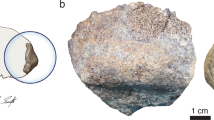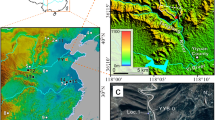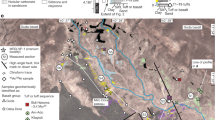Abstract
Excavations at Liang Bua, a large limestone cave on the island of Flores in eastern Indonesia, have yielded evidence for a population of tiny hominins, sufficiently distinct anatomically to be assigned to a new species, Homo floresiensis1. The finds comprise the cranial and some post-cranial remains of one individual, as well as a premolar from another individual in older deposits. Here we describe their context, implications and the remaining archaeological uncertainties. Dating by radiocarbon (14C), luminescence, uranium-series and electron spin resonance (ESR) methods indicates that H. floresiensis existed from before 38,000 years ago (kyr) until at least 18 kyr. Associated deposits contain stone artefacts and animal remains, including Komodo dragon and an endemic, dwarfed species of Stegodon. H. floresiensis originated from an early dispersal of Homo erectus (including specimens referred to as Homo ergaster and Homo georgicus)1 that reached Flores, and then survived on this island refuge until relatively recently. It overlapped significantly in time with Homo sapiens in the region2,3, but we do not know if or how the two species interacted.
This is a preview of subscription content, access via your institution
Access options
Subscribe to this journal
Receive 51 print issues and online access
$199.00 per year
only $3.90 per issue
Buy this article
- Purchase on Springer Link
- Instant access to full article PDF
Prices may be subject to local taxes which are calculated during checkout





Similar content being viewed by others
References
Brown, P. et al. A new small-bodied hominin from the Late Pleistocene of Flores, Indonesia. Nature 431, 1055–1061 (2004)
Barker, G. et al. The Niah Cave Project: the second (2001) season of fieldwork. Sarawak Mus. J. 56 (new ser. 77), 37–119 (2001)
Bowler, J. M. et al. New ages for human occupation and climatic change at Lake Mungo, Australia. Nature 421, 837–840 (2003)
Morwood, M. J., O'Sullivan, P. B., Aziz, F. & Raza, A. Fission-track ages of stone tools and fossils on the east Indonesian island of Flores. Nature 392, 173–176 (1998)
Morwood, M. J. et al. Archaeological and palaeontological research in central Flores, east Indonesia: results of fieldwork, 1997–98. Antiquity 73, 273–286 (1999)
Bird, M. I. et al. Radiocarbon dating of “old” charcoal using a wet oxidation, stepped-combustion procedure. Radiocarbon 41, 127–140 (1999)
Turney, C. S. M. et al. Early human occupation at Devil's Lair, southwestern Australia 50,000 years ago. Quaternary Research 55, 3–13 (2001)
Aitken, M. J. An Introduction to Optical Dating (Oxford Univ. Press, Oxford, 1998)
Bøtter-Jensen, L., McKeever, S. W. S. & Wintle, A. G. Optically Stimulated Luminescence Dosimetry (Elsevier Science, Amsterdam, 2003)
Huntley, D. J. & Lamothe, M. Ubiquity of anomalous fading in K-feldspars and the measurement and correction for it in optical dating. Can. J. Earth Sci. 38, 1093–1106 (2001)
Franklin, A. D., Prescott, J. R. & Robertson, G. B. Comparison of blue and red TL from quartz. Radiat. Meas. 32, 633–639 (2000)
Stokes, S. & Fattahi, M. Red emission luminescence from quartz and feldspar for dating applications: an overview. Radiat. Meas. 37, 383–395 (2003)
van den Bergh, G. D. The Late Neogene elephantoid-bearing faunas of Indonesia and their palaeozoogeographic implications. A study of the terrestrial faunal succession of Sulawesi, Flores and Java, including evidence for early hominid dispersal east of Wallace's Line. Scripta Geologica 117, 1–419 (1999)
Roberts, R. G., Jones, R. & Smith, M. A. Thermoluminescence dating of a 50,000 year-old human occupation site in northern Australia. Nature 345, 153–156 (1990)
Roberts, R. G. et al. The human colonisation of Australia: optical dates of 53,000 and 60,000 years bracket human arrival at Deaf Adder Gorge, Northern Territory. Quaternary Sci. Rev. 13, 575–583 (1994)
Gillespie, R. Dating the first Australians. Radiocarbon 44, 455–472 (2002)
O'Connor, S., Spriggs, M. & Veth, P. Excavation at Lene Hara Cave establishes occupation in East Timor at least 30,000–35,000 years ago. Antiquity 76, 45–49 (2002)
O'Connell, J. F. & Allen, J. Dating the colonization of Sahul (Pleistocene Australia–New Guinea): a review of recent research. J. Archaeol. Sci. 31, 835–853 (2004)
Maringer, J. & Verhoeven, Th. Die steinartefakte aus der Stegodon-fossilschicht von Mengeruda auf Flores, Indonesien. Anthropos 65, 229–247 (1970)
Sondaar, P. Y. et al. Middle Pleistocene faunal turnover and colonisation of Flores (Indonesia) by Homo erectus. C. R. Acad. Sci. Paris (Série II) 319, 1255–1262 (1994)
O'Sullivan, P. B. et al. Archaeological implications of the geology and chronology of the Soa Basin, Flores, Indonesia. Geology 29, 607–610 (2001)
Acknowledgements
Our work is funded by a Discovery Project grant to M.J.M. from the Australian Research Council (ARC), and by grants from the University of New England (M.J.M.) and the University of Wollongong (R.G.R.). R.G.R. holds an ARC Senior Research Fellowship, and C.S.M.T. and J.-x.Z. hold ARC Queen Elizabeth II Fellowships. C.S.M.T. also acknowledges the support of the Australian Academy of Science (J. G. Russell Award), the Natural Environment Research Council and Queen's University Belfast. The 2003 excavations at Liang Bua were undertaken under Indonesian Centre for Archaeology Permit Number 1178/SB/PUS/BD/24.VI/2003. Other participants included Jatmiko, E. Wahyu Saptomo, S. Wasisto, A. Gampar, C. Lentfer, N. Polhaupessy, K. Grant, B. Walker, A. Brumm, Rikus, Deus, Leo, Ansel, Agus, Seus, Camellus, Gaba, Rius, Beni and Piet. H. Yoshida and J. Abrantes assisted with IRSL and TL analyses, J. Olley made the high-resolution gamma spectrometry measurements, D. Huntley and O. Lian provided advice on anomalous fading, and R. Bailey suggested the isothermal measurement of red TL. Wasisto, M. Roach and K. Morwood assisted with the stratigraphic sections, plans and stone artefact drawings, and P. Brown and P. Jordan commented on earlier drafts of this paper.Author contributions M.J.M., R.P.S. and R.G.R. planned and now co-ordinate the research program funded by the ARC Discovery Project grant, which includes the Liang Bua project. T.S. directed aspects of the excavations and analyses. Ages were provided by R.G.R. and K.E.W. (luminescence); C.S.M.T., M.I.B. and L.K.F. (14C); W.J.R. (ESR); and J.-x.Z. (uranium-series). R.A.D. and G.D.v.d.B. analysed the faunal remains, and M.W.M. the stone artefacts. D.R.H. supervised the stratigraphic section drawings and other aspects of the project.
Author information
Authors and Affiliations
Corresponding authors
Ethics declarations
Competing interests
The authors declare that they have no competing financial interests.
Supplementary information
Supplementary Methods and Table 1
Supplementary Methods of archaeological excavation, radiocarbon dating, luminescence dating, thermal ionisation mass spectrometry (TIMS) uranium-series dating, and coupled electron spin resonance (ESR)/uranium-series dating; list of ages and supporting data in Supplementary Table 1 (a) radiocarbon dating, (b) luminescence dating, (c) TIMS uranium-series dating, (d) ESR dating, and (e) coupled ESR/uranium-series dating; list of references cited in Supplementary Methods and Supplementary Table 1. (PDF 167 kb)
Rights and permissions
About this article
Cite this article
Morwood, M., Soejono, R., Roberts, R. et al. Archaeology and age of a new hominin from Flores in eastern Indonesia. Nature 431, 1087–1091 (2004). https://doi.org/10.1038/nature02956
Received:
Accepted:
Issue Date:
DOI: https://doi.org/10.1038/nature02956
This article is cited by
-
More than a decade of genetic research on the Denisovans
Nature Reviews Genetics (2024)
-
Characterising the stone artefact raw materials at Liang Bua, Indonesia
Journal of Paleolithic Archaeology (2022)
-
Investigating the palaeoenvironmental context of Late Pleistocene human dispersals into Southeast Asia: a review of stable isotope applications
Archaeological and Anthropological Sciences (2022)
-
Constraining the Likely Technological Niches of Late Middle Pleistocene Hominins with Homo naledi as Case Study
Journal of Archaeological Method and Theory (2021)
-
Pleistocene Water Crossings and Adaptive Flexibility Within the Homo Genus
Journal of Archaeological Research (2021)
Comments
By submitting a comment you agree to abide by our Terms and Community Guidelines. If you find something abusive or that does not comply with our terms or guidelines please flag it as inappropriate.



